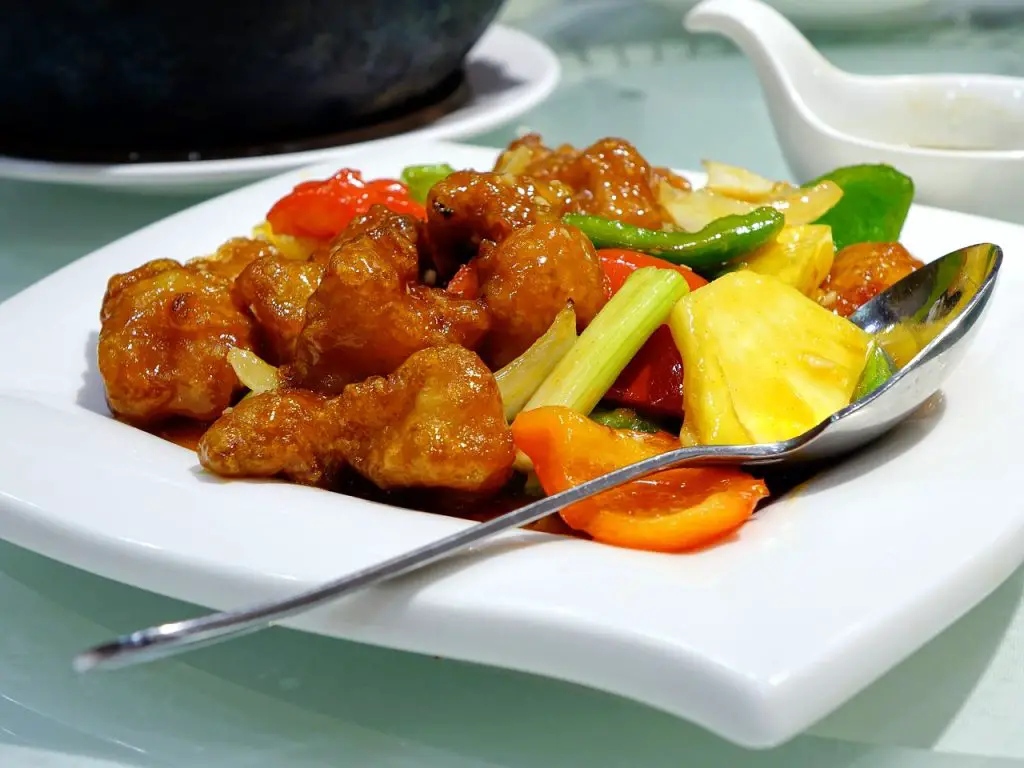Sweet and Sour Pork is a classic Chinese dish that has captured the hearts and taste buds of people worldwide. This delectable combination of crispy, succulent pork pieces coated in a sweet and tangy sauce is a testament to the rich culinary tradition of Chinese cuisine. In this article, we will delve into the history of Sweet and Sour Pork, explore its diverse variations, and provide you with a step-by-step guide to prepare this iconic dish in your own kitchen.
The History of Sweet and Sour Pork
To truly appreciate the depth of Sweet and Sour Pork, it’s essential to understand its historical roots in Chinese cuisine. While the dish has become a beloved staple in Chinese-American restaurants, its origins date back to ancient China. The concept of sweet and sour flavors has long been a part of Chinese culinary history, with the use of vinegar and sugar as common ingredients in various dishes.
Sweet and Sour Pork, or “gu lou yok” in Cantonese, is believed to have originated in the Guangdong province of southern China, known for its diverse and flavorful cuisine. The dish made its way to the United States and other parts of the world thanks to Chinese immigrants in the 19th and early 20th centuries, who adapted their traditional recipes to suit local tastes. Over time, Sweet and Sour Pork evolved to incorporate a wider range of ingredients and techniques, resulting in various regional variations.
Variations of Sweet and Sour Pork
One of the fascinating aspects of Sweet and Sour Pork is the myriad of regional and cultural variations it has spawned. While the core concept remains the same—crispy pork and a sweet and tangy sauce—different regions have put their own spin on this beloved dish. Here are a few notable variations:
Cantonese Sweet and Sour Pork:
The original and most well-known version features deep-fried pork chunks coated in a glossy, reddish-brown sauce made from vinegar, sugar, ketchup, and various seasonings.
Often includes bell peppers, onions, and pineapple chunks, adding color and flavor to the dish.
A balance of sweet and tangy flavors is a hallmark of Cantonese cuisine, making this version of Sweet and Sour Pork a delightful symphony of tastes.
Shanghainese Sweet and Sour Pork:
In Shanghai, Sweet and Sour Pork, or “tang cu li ji,” is prepared with a thinner, more delicate batter that results in a crispier texture.
The sauce tends to be slightly less sweet and tangy compared to the Cantonese version, with a more nuanced flavor profile.
Typically includes ingredients like preserved vegetables and Worcestershire sauce for added depth.
Sichuan Sweet and Sour Pork:
Sichuan-style Sweet and Sour Pork, known as “suan tian rou,” adds a spicy twist to the classic dish.
The sauce incorporates Sichuan peppercorns and chili peppers, providing a tongue-tingling heat that complements the sweet and sour elements.
This version often includes vegetables like carrots, celery, and wood ear mushrooms for added texture.
Thai Sweet and Sour Pork:
In Thailand, Sweet and Sour Pork, or “mu pad prik king,” features a distinct blend of Thai flavors.
The sauce includes ingredients like tamarind paste, fish sauce, and Thai chili peppers, giving it a unique Southeast Asian flair.
Thai basil leaves and sliced red and green chilies are commonly added for an extra kick of freshness and heat.
Making Sweet and Sour Pork at Home
Now that we’ve explored the history and regional variations of Sweet and Sour Pork, let’s dive into the exciting process of making this mouthwatering dish at home. Here’s a step-by-step guide:
Ingredients:
For the Pork:
1 pound (450g) boneless pork loin, cut into 1-inch cubes
1/2 teaspoon salt
1/4 teaspoon white pepper
1/2 cup cornstarch
2 eggs, beaten
Vegetable oil for frying
For the Sweet and Sour Sauce:
1/2 cup ketchup
1/4 cup rice vinegar
1/4 cup white sugar
2 tablespoons soy sauce
1 tablespoon cornstarch
1/4 cup water
1/2 cup pineapple chunks
1/2 cup bell pepper, cut into chunks
1/2 cup onion, cut into chunks
Instructions:
Marinate the Pork:
In a bowl, combine the pork cubes with salt and white pepper. Let it marinate for at least 15 minutes to allow the flavors to penetrate the meat.
Prepare the Batter:
In a separate bowl, place the cornstarch. Dip each pork cube into the beaten eggs, then coat them evenly with cornstarch, pressing the cornstarch onto the pork to create a thick, even coating.
Fry the Pork:
Heat vegetable oil in a deep frying pan or wok to 350°F (175°C). Carefully add the coated pork cubes one by one, making sure not to overcrowd the pan. Fry in batches if necessary.
Fry the pork until it turns golden brown and crispy, about 4-5 minutes. Remove with a slotted spoon and place on a plate lined with paper towels to drain excess oil.
Make the Sweet and Sour Sauce:
In a separate saucepan, combine ketchup, rice vinegar, white sugar, soy sauce, and cornstarch. Mix well until the cornstarch is fully dissolved.
Add water to the saucepan and stir. Heat the sauce over medium heat, stirring constantly until it thickens and becomes glossy.
Combine Pork and Sauce:
In a large skillet or wok, heat a small amount of oil over medium-high heat. Add the pineapple chunks, bell pepper, and onion. Stir-fry for about 2 minutes until they start to soften.
Pour the prepared sweet and sour sauce over the cooked vegetables and stir to combine.
Add the fried pork cubes to the sauce and gently toss to coat them evenly.
Serve:
Transfer the Sweet and Sour Pork to a serving platter. Garnish with chopped green onions or sesame seeds if desired.
Serve hot with steamed rice or noodles.
Sweet and Sour Pork is a culinary masterpiece that embodies the essence of Chinese cuisine—diverse flavors, contrasting textures, and a harmonious balance between sweet and sour elements. Its rich history and numerous regional variations showcase the adaptability and creativity of Chinese culinary traditions.
Preparing Sweet and Sour Pork at home offers a delightful opportunity to explore the art of Chinese cooking while savoring the satisfaction of creating this beloved dish from scratch. Whether you choose to follow the classic Cantonese recipe or experiment with regional twists, your taste buds are in for a treat.
So, gather your ingredients, roll up your sleeves, and embark on a flavorful journey through the world of Sweet and Sour Pork. Whether you’re a novice in the kitchen or an experienced cook, this iconic dish is sure to bring joy to your dining table and leave a lasting impression on your palate.
Tips for Perfect Sweet and Sour Pork
While the recipe for Sweet and Sour Pork is relatively straightforward, achieving perfection in taste and texture requires attention to detail and a few handy tips:
Choose the Right Cut of Pork:
Opt for boneless pork loin or tenderloin for the best results. These cuts are lean and tender, making them ideal for creating succulent, crispy pork pieces.
Maintain Consistency in Pork Cube Size:
Cut the pork cubes into uniform 1-inch pieces to ensure even cooking. This will result in perfectly crispy and tender pork bites.
Ensure Proper Frying Temperature:
Use a food thermometer to monitor the oil temperature when frying. Maintain a steady temperature of 350°F (175°C) to achieve crispy, non-greasy pork.
Fry in Batches:
Avoid overcrowding the frying pan or wok when frying the pork. Frying in batches allows each piece to cook evenly and achieve that desired crispiness.
Drain Excess Oil:
After frying, place the cooked pork on a plate lined with paper towels to absorb any excess oil. This step helps maintain the crispy texture and prevents the dish from becoming greasy.
Customize Your Vegetables:
Feel free to experiment with vegetables to suit your preferences. Alongside bell peppers and onions, you can add carrots, snow peas, or any other colorful veggies you like.
Adjust Sweet and Sour Sauce:
Taste the sauce as you go and adjust the sweetness or tanginess to your liking. You can add a bit more sugar for extra sweetness or vinegar for a sharper tang.
Don’t Overcook Vegetables:
When stir-frying the vegetables, avoid overcooking them. They should remain crisp and vibrant, adding a delightful crunch to the dish.
Garnish and Serve Fresh:
Fresh garnishes like chopped green onions, cilantro, or sesame seeds can elevate the presentation and flavor of your Sweet and Sour Pork. Sprinkle them on just before serving.
Serving Sweet and Sour Pork
Sweet and Sour Pork is a versatile dish that can be served in various ways, depending on your preferences and the occasion:
Main Course:
Serve Sweet and Sour Pork as the star of the meal with a side of steamed rice or noodles. This hearty combination makes for a satisfying and balanced meal.
Appetizer or Snack:
Make smaller bite-sized pieces of Sweet and Sour Pork and serve them as appetizers or party snacks. Provide toothpicks or skewers for easy enjoyment.
Family Dinner:
It’s an excellent choice for a family dinner or gathering, as it appeals to both children and adults with its sweet and tangy flavors.
Meal Prep:
Sweet and Sour Pork can be prepared in advance and stored in the refrigerator for a quick and delicious meal option during busy weekdays.
Sweet and Sour Pork is a beloved Chinese dish that has transcended cultural boundaries to become a favorite in kitchens around the world. Its rich history and regional variations offer a testament to the diversity and creativity of Chinese cuisine.
By following the step-by-step guide and tips provided in this article, you can embark on a culinary adventure in your own kitchen and create a homemade Sweet and Sour Pork dish that’s sure to impress your family and friends. Whether you prefer the classic Cantonese version or want to explore regional twists, the sweet and tangy flavors combined with crispy, succulent pork make for an unforgettable dining experience.
So, gather your ingredients, embrace the art of Chinese cooking, and savor the delightful balance of flavors that Sweet and Sour Pork has to offer. Whether you enjoy it as a main course, appetizer, or snack, this iconic dish is sure to bring joy to your table and leave a lasting imprint on your taste buds.




